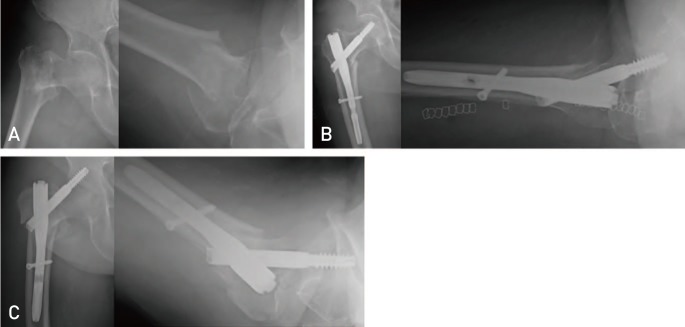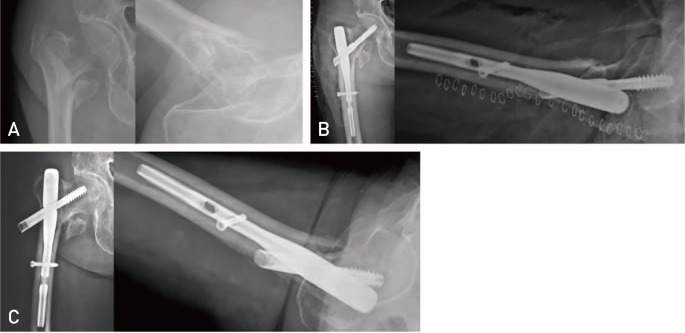Hip Pelvis.
2018 Sep;30(3):168-174. 10.5371/hp.2018.30.3.168.
Local Postoperative Complications after Surgery for Intertrochanteric Fractures Using Cephalomedullary Nails
- Affiliations
-
- 1Department of Orthopaedic Surgery, Kangwon National University College of Medicine, Chuncheon, Korea. hkyljh@kangwon.ac.kr
- KMID: 2419512
- DOI: http://doi.org/10.5371/hp.2018.30.3.168
Abstract
- PURPOSE
Cephalomedullary nails (CMN) are commonly used for the surgical treatment of intertrochanteric fractures. This study aimed to evaluate overall postoperative local complications by reviewing patients who received surgical treatment using three different types of implants.
MATERIALS AND METHODS
The study sample included 353 patients (107 males, 246 females) who underwent surgery using CMN for intertrochanteric fractures. Three different types of implants were used: i) the Gamma3® (Stryker) in 80 cases, ii) the Targon® PF (Aesculap) in 225 cases, and iii) the Compression Hip Nail® (Trademedics) in 48 cases. The mean age was 82.6 (range, 60-109) years and the average follow-up period was 15 (range, 6-80) months. Postoperative local complications and risk factors of cut-out were assessed.
RESULTS
The most common complication was cut-out (n=26). Other complications included non-union (n=3), periprosthetic fracture (n=2), avascular necrosis (n=1), heterotopic ossification (n=1), and sleeve pull out (n=1). Multivariate analysis revealed that the cut-out group had a higher rate of poor reduction compared to the non-complicated group (P < 0.001). Although the mean tip-apex distance (TAD) was 18.4 mm in the non-complicated group, lower than that of the cut-out group (P=0.001), multivariate analysis revealed that TAD was not a significant risk factor for cut-out (P=0.065).
CONCLUSION
Cut-out is the most common local complication associated with surgical treatment of intertrochanteric fractures using CMN. Proper reduction appears to be important in lowering the risk of cut-out. Maintaining low TAD is another critical factor in achieving sufficient fixation of lag screw to the subchondral bone of the femoral head.
MeSH Terms
Figure
Reference
-
1. Anglen JO, Weinstein JN. American Board of Orthopaedic Surgery Research Committee. Nail or plate fixation of intertrochanteric hip fractures: changing pattern of practice. A review of the American Board of Orthopaedic Surgery database. J Bone Joint Surg Am. 2008; 90:700–707. PMID: 18381305.2. Lee YK, Yoon BH, Nho JH, Kim KC, Ha YC, Koo KH. National trends of surgical treatment for intertrochanteric fractures in Korea. J Korean Med Sci. 2013; 28:1407–1408. PMID: 24015052.
Article3. Flahiff CM, Nelson CL, Gruenwald JM, Hollis JM. A biomechanical evaluation of an intramedullary fixation device for intertrochanteric fractures. J Trauma. 1993; 35:23–27. PMID: 8331708.
Article4. Lee YK, Chung CY, Park MS, Lee KM, Koo KH. Intramedullary nail versus extramedullary plate fixation for unstable intertrochanteric fractures: decision analysis. Arch Orthop Trauma Surg. 2013; 133:961–968. PMID: 23644897.
Article5. Socci AR, Casemyr NE, Leslie MP, Baumgaertner MR. Implant options for the treatment of intertrochanteric fractures of the hip: rationale, evidence, and recommendations. Bone Joint J. 2017; 99-B:128–133. PMID: 28053268.6. Baumgaertner MR, Curtin SL, Lindskog DM, Keggi JM. The value of the tip-apex distance in predicting failure of fixation of peritrochanteric fractures of the hip. J Bone Joint Surg Am. 1995; 77:1058–1064. PMID: 7608228.
Article7. Gundle R, Gargan MF, Simpson AH. How to minimize failures of fixation of unstable intertrochanteric fractures. Injury. 1995; 26:611–614. PMID: 8550168.
Article8. Cleveland M, Bosworth DM, Thompson FR, Wilson HJ Jr, Ishizuka T. A ten-year analysis of intertrochanteric fractures of the femur. J Bone Joint Surg Am. 1959; 41-A:1399–1408. PMID: 13849408.
Article9. Fogagnolo F, Kfuri M Jr, Paccola CA. Intramedullary fixation of pertrochanteric hip fractures with the short AO-ASIF proximal femoral nail. Arch Orthop Trauma Surg. 2004; 124:31–37. PMID: 13680275.
Article10. Born CT, Karich B, Bauer C, von Oldenburg G, Augat P. Hip screw migration testing: first results for hip screws and helical blades utilizing a new oscillating test method. J Orthop Res. 2011; 29:760–766. PMID: 20830738.
Article11. Park BK, Plymale M, Capogna BM, Kim SJ. A new addition to the third-generation Gamma nail system. Curr Orthop Pract. 2011; 22:280–283.
Article12. Park IH, Won JK, Han KY. Treatment of intertrochanteric fractures using Targon proximal femoral nails. Hip Pelvis. 2012; 24:117–123.
Article13. Parker MJ, Bowers TR, Pryor GA. Sliding hip screw versus the Targon PF nail in the treatment of trochanteric fractures of the hip: a randomised trial of 600 fractures. J Bone Joint Surg Br. 2012; 94:391–397. PMID: 22371549.14. Choo SK, Oh HK, Ko HT, Min DU, Kim Y. Effectiveness of controlled telescoping system for lateral hip pain caused by sliding of blade following intramedullary nailing of trochanteric fracture. Injury. 2017; 48:2201–2206. PMID: 28801201.
Article15. Geller JA, Saifi C, Morrison TA, Macaulay W. Tip-apex distance of intramedullary devices as a predictor of cut-out failure in the treatment of peritrochanteric elderly hip fractures. Int Orthop. 2010; 34:719–722. PMID: 19618186.
Article
- Full Text Links
- Actions
-
Cited
- CITED
-
- Close
- Share
- Similar articles
-
- New Approach in the Treatment of Intertrochanteric Fracture Using a Cephalomedullary Nail
- Internal Fixation of Pauwels Type-3 Undisplacedincomplete Insufficiency Femoral Neck Fractures with Cephalomedullary Nails
- Comparison of Cephalomedullary Nails with Sliding Hip Screws in Surgical Treatment of Intertrochanteric Fractures: A Cumulative MetaAnalysis of Randomized Controlled Trials
- Surgical Results of the Cephalomedullary Nail for the Femoral Intertrochanteric Fracture: Comparison between Non-experienced Surgeons and Experienced Surgeon
- A Comparison of U-blade Gamma3 and Gamma3 Nails Used for the Treatment of Intertrochanteric Fractures



